Haryana State Board HBSE 10th Class Science Important Questions Chapter 11 Human Eye and Colourful World Important Questions and Answers.
Haryana Board 10th Class Science Important Questions Chapter 11 Human Eye and Colourful World
Question 1.
Explain the functions of the main parts of a human eye along with a diagram.
Answer:
The human eye is one of the most valuable and sensitive sense organs. It enables us to see the wonderful world and its colours.
Structure and working of human eyes:
1. The human eye is the best natural optical instrument whose construction and working can be compared with a camera.
Working of eyes:
1. The light rays coming from the object enter the eye through cornea. The cornea forms a transparent bulge in front of the eye-balls. The eye-ball is almost spherical shaped and has a diameter of about 2.3 cm.
2. Just behind the cornea, there lies a dark muscular diaphragm called ins which controls the amount of light that enters the eye.
![]()
3. There is a hole in the iris which is the aperture of the eye i.e. the pupil of eye.
- The size of this aperture or pupil is controlled by iris.
4. After passing through the pupil, the light rays are incident on the eye-lens.
The eye lens is a convex lens made of transparent jelly like material.
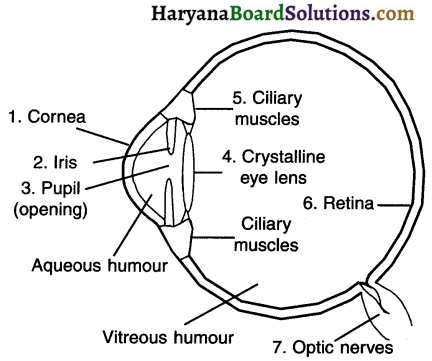
5. Ciliary muscles hold the eye lens.
- Ciliary muscles change the thickness of the eye lens while focusing. In other words, the focal length of eye lens can be changed by changing its shape with the help of ciliary muscles. This helps in proper viewing of the objects.
6. The screen on which the image is formed in the eye is called retina.
- The retina is a delicate membrane having a large number of light sensitive cells.
- When light rays falls on retina, its light sensitive cells generate electrical signals.
7. The retina sends these signals to the brain through optic nerve.
- The brain interprets the image of the object. The eye lens forms an inverted real image of the objects on the retina.
- This interpretation allows us to see the objects.
![]()
Question 2.
Explain accommodation power of an eye.
Answer:
Accommodation power of an eye:
1. The ability of the eye lens to adjust its focal length as per requirement so that objects can be seen clearly is called accommodation power of an eye.
2. With the help of ciliary muscles, an eye can focus the images of the distant objects as well as the near by objects on its retina by changing the focal length of its lens.
3. When the eyes are looking at a distant object, the ciliary muscles are relaxed, the lens is thin and focal length is more. This enables eye to see the distant object clearly.
4. Similarly when the ciliary muscles contract, the curvature of the eye lens increase and focal length decreases. This enables to see nearby objects clearly.
Question 3.
Explain Near point of an eye and far point of an eye.
Answer:
(i) Near point of an eye :
- The minimum distance at which the objects can be seen clearly without contracting the eye lens
i. e. without any strain is called the least distance of the distinct vision or near point of an eye. - For a young adult having normal vision, the near point of the eye is 25 cm.

(ii) Far point of an eye :
- The farthest distance up to which the eye can see objects clearly is called far point of an eye.
- The farthest point of a person with normal vision lies at an infinite distance. This is so because the maximum distance an individual can see cannot be measured.
- Thus, a person with normal vision can see objects clearly from 25 cm to infinite distance.
![]()
Question 4.
How do ciliary muscles help to see nearby and far objects?
Answer:
1. The lens of our eyes is made up of a fibrous jelly-like material. Because the lens is made with such flexible material its shape or say curvature can be changed while seeing the object. The ciliary muscles have the ability to change the curvature and hence the focal length of the eyes.
2. When the ciliary muscles are in relaxed position, the lens remains thin. So, the focal length of the lens increases and we can see far-off objects clearly.
3. When we look at objects closer to us (for example, while reading), the ciliary muscles contract. This increases the curvature of the eye lens and the lens become thicker. The focal length decreases and so we are able to see nearby objects clearly.
Question 5.
What is cataract?
Answer:
1. Sometimes, in old aged people, the crystalline lens of the eyes becomes milky and cloudy.
2. As a result, the vision becomes hazy or even opaque due to the formation of a membrane over the lens. This condition is called cataract.
3. Cataract causes partial or complete loss of vision. The vision can be restored through cataract surgery-
Question 6.
How does defect of vision occur? Name the different types of defects of vision.
Answer:
1. The light rays coming from an object passes through the eye lens and forms an image on the retina of the eye.
2. To see objects clearly, image should be formed exactly on retina.
3. For this, the ciliary muscles in the eye change the thickness of the eye lens which results in the change of focal length of the eye.
4. When thickness of this lens does not change with respect to the object distance, the object cannot be seen properly. This is known as defect of vision.
5. The vision becomes blurred due to such refractive defects.
Types of defect of vision:
- Near sightedness or Myopia
- Far sightedness or Hypermetropia
- Presbyopia
![]()
Question 7.
What is the cause of short (near) sightedness in eye ? How can short sightedness defect be removed ? OR Write a short note on near sightedness or myopia.
Answer:
1. To see distant objects, the eye lens should become thin.
2. When the lens is unable to do so, the light rays converge more than they should. So, the image gets formed before the retina rather than on it. Hence, distant objects cannot be seen clearly.
3. This defect is known as near sightedness or myopia. Myopia arises due to
- Excessive curvature of the lens or
- Elongation of the eye ball.
4. To correct this defect, concave lens of appropriate focal length is used.

Question 8.
Write a short note on far sightedness (hypermetropia).
Answer:
1. If eye lens does not become thick as per the requirement, then the rays coming from nearby objects gets less converged and hence are focused behind the retina.
2. Due to this, the image is formed behind the retina and not exactly on the retina. Hence, nearby objects cannot be seen clearly.
3. The near point for person suffering from such defects is more than the normal near point of 25 cm. So, he has to keep a reading material at a distance much beyond 25 cm for reading comfortably.
4. This type of defect is known as far sightedness or hypermetropia.
5. This defect occurs due to less convergence of the light rays.
6. To correct this defect, convex lens of appropriate focal length is used.

Question 9.
Write a short note on aging-eye (presbyopia).
Answer:
Presbyopia:
1. Presbyopia which literally means aging eye’, is an age related eye condition which makes it difficult to see objects that are too close.
2. As a person grows older, the power of accommodation of an eye usually decreases.
3. The near point of aged people recedes and they find It difficult to see nearby objects clearly without spectacles. Such a defect is called presbyopia.
4. This defect arises due to weakened ciliary muscles and loss of elasticity of eye lens.
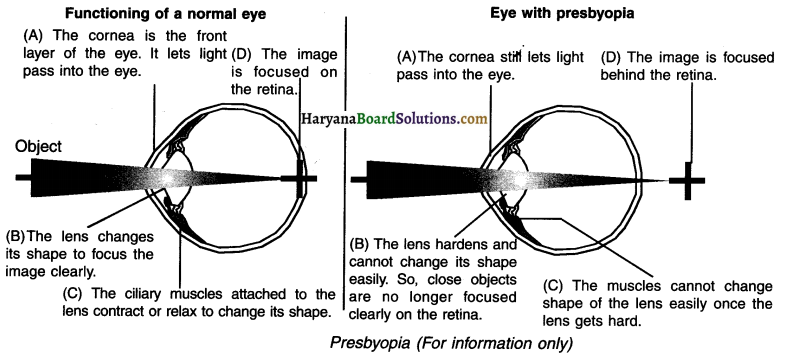
5. At times, people also find it difficult to see even distant objects without spectacles i.e. they suffer from both myopia as well as hypermetropia. Vision of such people can be cured using spectacles of bifocal lens.
6. The upper part of bifocal lens is made up of concave lens and its lower part is made up of convex lens.
![]()
Question 10.
Enlist the defects of vision in human eyes and their remedies.
Answer:
| Defects of vision | Remedies |
| 1. Near sightedness (Myopia) | Using concave lens of appropriate focal length can cure it. |
| 2. Far sightedness (Hypermetropia) | Using convex lens of appropriate focal length can cure it. |
| 3. Presbyopia | Using spectacles of bifocal lens i.e. convex and concave together can cure it. |
Question 11.
What is a prism? Draw its diagram.
Answer:
Prism:
1. A prism is a portion of a transparent medium bounded by two plane faces inclined to each other at a certain angle.
2. As shown in the figure, the prism has two triangular bases and three rectangular lateral surfaces (or faces). These surfaces are inclined to each other.
3. The angle between the two lateral faces is called the angle of prism.

Question 12.
Draw a ray diagram to show the path of a light ray that enters the glass prism obliquely. Label on it the angle of incidence and angle of deviation.
Answer:
1. The figure here shows the principle section ABC of a glass prism.
2. Ray PQ is an incident ray on face AB.
3. On entering the denser medium (grass) from rarer medium (air), the ray PQ bends towards the normal along the path QR. This means ray PQ got refracted.
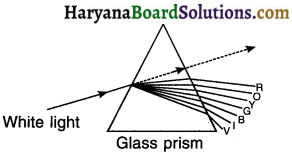
4. Ray QR again undergoes refraction when it hits face AC. The ray now travels from denser medium to rarer medium (air). Hence, it bends away from the normal. It emerges out as ray RS.
5. Angle ‘D’ between the incident ray PO and the emergent ray is called the angle of deviation i.e. the angle at which the incident ray deviates.
6. Angle ‘e’ made by the emergent ray with the normal to the retracting face ‘AC’ is called the angle of emergence. An important result is – i + e = A + D i.e. Angle of incidence + Angle of emergence = Angle of prism + Angle of deviation
![]()
Question 13.
What is dispersion of light? Which are the colours of the spectrum obtained from the dispersion through a glass prism?
Answer:
Dispersion of light:
1. Splitting of white light into its seven constituent colours on passing through a transparent medium like a glass prism is called dispersion of light.
2. When white light is incident on a prism, the prism decomposes the white light and hence a band of seven colours is obtained on the screen.
3. The band of these colours is known as spectrum.
On the screen, we get a band of seven colours in the following order from bottom to top:
Violet, Indigo, Blue, Green, Yellow, Orange and Red (VIBGYOR)
Question 14.
What is the reason behind formation of spectrum and refraction of light into seven colours?
Answer:
1. All the constituent colours of a white light have saine velocity in vacuum. However, when white light passes through a transparent medium like glass, water, glycerin, etc., velocity of the constituent colour changes and due to this, deviation of the different constituent colours occurs at different angles.
2. Each colour has a unique refractive index. Hence, the seven colours of the spectrum get refracted in different proportions.
Example:
- The velocity of violet light is least and so it bends the most.
- The velocity of red light is highest and so it bends the least.
- Hence, in a spectrum of prism, red colour is at the top while violet colour is at the bottom of the spectrum.
Question 15.
Explain the dispersion of white light by a glass prism using necessary figure. OR Explain
Answer:
1. Take two identical prisms P1 and P2 having same angles.
2. Arrange these prisms as shown in the figure.
3. Incident a beam of white light on prism P1.
4. The light coming out of the prism P1 will consist of seven colours.
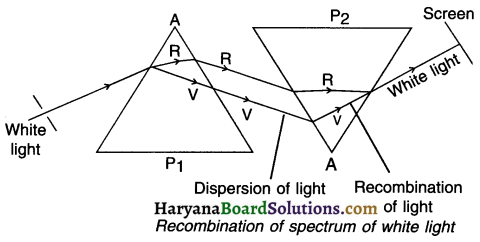
5. Arrange prism P2 if such a way that the band of seven colours of prism P1 falls properly on P2 and finally gives white beam of light on a screen.
6. From this experiment, Newton established that a white light is composed of seven constituent colours.
7. This way we can understand the structure of white light through the phenomenon of dispersion of light.
![]()
Question 16.
Explain formation of a rainbow with a neat diagram.
Answer:
Rainbow:
1. A rainbow is a natural spectrum visible in the sky after rain shower.
2. Rainbow is formed when the water droplets present in the atmosphere disperse the sunlight tailing on diem.
3. Note that a rainbow is always formed in the direction opposite to that of the sun.
Formation:
1. When sunlight falls on the atmospheric water drops, they first disperse the incident light and then reflect it internally (not necessarily total internal reflection).
2. Finally the light gets refracted again while it is coming out of rain drops.
3. We see different colours in a rainbow because light enters into our eye through dispersion and internal reflection.
4. In a rainbow, water droplets act as small prisms.
5. The colour at the bottom of the rainbow is violet while the top most colour is red. Such a rainbow is called a primary rainbow.
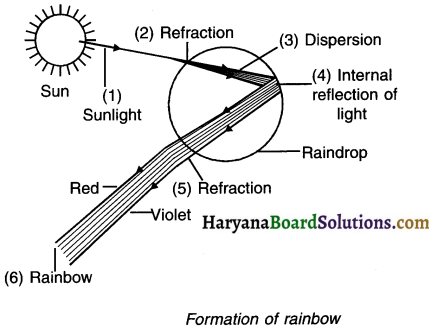
Question 17.
Draw the structure of rainbow formation.
Answer:
Rainbow:
1. A rainbow is a natural spectrum visible in the sky after rain shower.
2. Rainbow is formed when the water droplets present in the atmosphere disperse the sunlight tailing on diem.
3. Note that a rainbow is always formed in the direction opposite to that of the sun.
![]()
Formation:
1. When sunlight falls on the atmospheric water drops, they first disperse the incident light and then reflect it internally (not necessarily total internal reflection).
2. Finally the light gets refracted again while it is coming out of rain drops.
3. We see different colours in a rainbow because light enters into our eye through dispersion and internal reflection.
4. In a rainbow, water droplets act as small prisms.
5. The colour at the bottom of the rainbow is violet while the top most colour is red. Such a rainbow is called a primary rainbow.

Question 18.
What is atmospheric retraction? Which phenomena results from it?
Atmospheric refraction :
1. Atmosphere consists of layers of different densities spread across it. This means the density of atmosphere is not same everywhere.
2. The layer at lower altitude from the earth has more density than that at the higher altitude.
3. Due to this difference, the refractive index of atmosphere continuously decreases as one moves from lower to higher altitudes.
4. Moreover, the physical conditions of the refracting medium i.e. the atmospheric air keeps on changing. As a result, we feel that the position of an object in the atmosphere is changing.
5. This phenomenon is called atmospheric refraction or the refraction of light by earth’s atmosphere.
6. Phenomena such as twinkling of stars, early sunrise and delayed sunset occur due to this effect.
Question 19.
Write a note on twinkling of stars. OR Stars seem higher than they actually are. Explain. OR Explain twinkling of stars in detail.
Answer:
1. Density of atmosphere is not uniform everywhere.
2. There are different layers of atmosphere with different refractive indices.
3. Atmospheric layer at lower altitude is colder and denser compared to layer at higher altitude.
4. When the light travels from star at rarer medium towards earth at denser medium, in bends towards normal.
5. Thus, due to refraction towards normal,the position of star appears higher from its actual position.
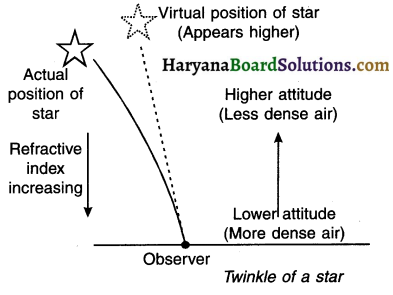
Reason for twinkling of stars:
1. The physical condition of refracting medium .e. the earth’s atmosphere is not stationary. Hence, the position of star seems to be changing continuously.
2. This results in the continuous change in the path of the rays coming from the stars and continuous change in the intensity of light. This leads to twinkling of stars.
3. Light from a star is refracted or say bent as it leaves the space and enters the earth’s atmosphere.
4. Air at higher altitude is rare whereas near the earth’s surface it is dense.
5. As a result, when light from the star comes down, the dense air bends the light more.
6. Due to this, refraction of star’s light, the star appears to be at a higher position than it actually is.
![]()
Question 20.
Why do we experience early sunrise and delayed sunset when actually it is not so? OR Our day is longer by four minutes. Give reason.
Answer:
1. Actual sunrise means actual appearance of the sun at the horizon.
2. When the sun is slightly below the horizon,the sun rays pass from less dense air to more dense air in the atmosphere and get refracted downwards.
3. Due to this atmospheric refraction, the sun appears to be raised above the horizon when actually it is still slightly below the horizon. Thus, we can see sunrise two minutes before it actually comes to horizon.
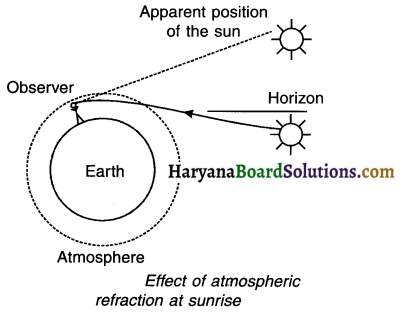
4. In the same way, when sun is setting i.e. when it moves below the horizon, it is seen to us for two minutes.
5. In total, 2 minutes early sunrise and 2 minutes delayed sunset make our day longer by four minutes.
6. Thus, we experience early sunrise and delayed sunset when actually it is not so.
Question 21.
What is scattering of light? On what factors does it depend?
Answer:
Scattering of light:
- The deflection of light by minute particles and molecules in all the directions is known as scattering of light.
- The colour of scattered light depends upon the size of scattering particles.
- For example, minute particles scatter light of small wavelength such as blue colour.
- Whereas bigger particles scatter light of larger wavelength such as red colour.
- If the size of scattering particles is much bigger, the scattered light appears white.
Question 22.
Describe Tyndall effect.
Answer:
Tyndall effect:
1. The earth’s atmosphere is a heterogeneous mixture of smoke particles, tiny water droplets and air particles.
2. When light falls on such colloidal particles, a path of light beam becomes visible.
3. This phenomenon is known as Tynciall effect.
4. The light rays reach us after getting deflected in all directions from these particles.
5. Commercially, Tyndall effect helps in determining the density of aerosol and other colloidal particles that are emitted.
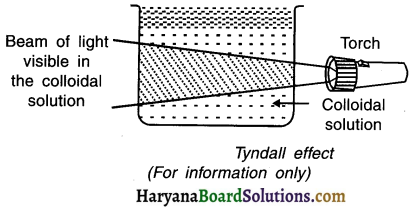
Examples:
- When a fine beam of sun light enters a room filled with smoke through a small hole, a path of light beam can be seen due to Tyndall effect.
- When sunlight enters a canopy of dense forests, Tyndall effect can be seen due to scattering of light through tiny water droplets of the mist.
- Sometimes smoke emitted by the combustion of engine oil appears blue in colour.
![]()
Question 23.
Why does clean sky appear blue in colour?
Answer:
1. The sunlight is made up of seven colours.
2. When sunlight passes through the atmosphere, most of the longer wavelength lights such as red, orange, yellow, etc. present in it do not get scattered much by the molecules of the air and other fine particles and hence pass through straight.
3. The shorter wavelength blue light is however scattered all around the sky by air molecules in the atmosphere.
4. The wavelength of red light is about 1.8 times more than that of blue colour.
5. Thus, when sunlight passes through the atmosphere the tine particles in the air scatter blue colour more strongly than red.
6. As a result, the sky appears blue.
Question 24.
Why does sun appear reddish at sunrise and sunset?
Answer:
1. White light coming from the sun has to travel a large distance in the atmosphere before reaching to the observer.
2. During sunrise or sunset, most of the blue colour present in sunlight has been scattered out and it is away from our sight.
3. As a result, only red light remains present in the beam of sunlight and so only red colour reaches our eye.

Question 25.
Why do some people use spectacles with bifocal lenses?
Answer:
1. Some people suffer from near-sightedness (myopia) as well far-sightedness (hypermetropia).
2. Myopia can be cured with concave lens whereas hypermetropia with convex lens. Spectacles with bifocal lens have two lenses namely concave and convex to overcome this problem.
3. Hence, people suffering from both myopia as well as hypermetropia wear bifocal lens.
Question 26.
In the figure, a narrow beam of white light is shown to pass through a triangular glass prism. After passing through the prism it produces a spectrum XV on a screen.
(a) State the colour seen at X and Y.
(b) Why do different colours of white light bend through different angles with respect to the incident beam of light?
Answer:
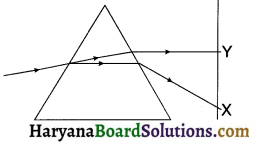
(a) ‘X’ represents violet colour and ‘Y’ represents red.
(b) The refractive index of glass is different for different colours.
Hence, the different colours present in the white light bend at different angles at the prism.
Question 27.
A beam of white light falling on a glass prism gets split up into seven colours marked 1 to 7 as shown in the diagram.
A student makes the following statements about the spectrum observed on the screen:
Answer:

(a) The colours at positions marked 3 and 5 are similar to the colour of the sky and the core of a hard boiled egg respectively. Is the statement made by the student correct or incorrect? Justify.
(b) Which two positions correspond closely to the colour of the colour of —
(i) A solution of potassium permanganate? (ii) ‘Danger’ or stop signal lights?
Answer:
The colours of the spectrum observed on the screen are in the order:

(a) The statement made by the student is incorrect. The colour at position 3 is yellow while the sky is blue. The colour at position 5 is blue while the core of the boiled egg is yellow.
(b) (i) Solution of potassium permanganate is violet coloured. Position 7 corresponds to this colour.
(ii) Danger or stop signal lights are of red colour. Position 1 corresponds to this colour.
![]()
Question 28.
Stars and planets both belong to space, even then stars twinkle but planets do not. Give reason.
Answer:
1. The stars are very far from us and so they may be considered as the point sources of light.
2. Compared to stars, planets are much nearer to the earth and so planets appear quite big.
3. Hence, planets cannot be considered a single point source of light but collection of a very large number of point sources of light.
4. Thus, on the whole, the brightness of the planet always remains the same and it does not appear to twinkle. But the atmospheric refraction affects stars more since they are point sources of light and so stars twinkle.
Question 29.
Why are danger signal lights red in colour? OR Signal lights used to indicate danger are red in colour. Give reason.
Answer:
1. Wavelength of red colour is quite large. It does, not allow light to scatter much.
2. Thus when red coloured light is used, it gets scattered least in fog or smoke and so it can be seen from a long distance.
3. Hence, red coloured light is used to indicate danger.
Question 30.
There was a beautiful village in a Himalayan valley. When trains passed from the village, the whistle and the sound of train, mixed with the sound of waterfall, seemed to be very pleasant to everyone. Children loved this and so they used to play near the railway track. On one foggy day, a group of children found that a fishplate was missing from the track. This worried all the villagers. One of the children Raghav placed his ear on the railway track and tried to know if a train was coming. He asked his friends to inform the nearest railway station and he himself put-off his red shirt and started running towards the train, waving his red shirt. The engine driver sensed some danger and stopped the train. A major accident was averted.
Questions:
- Name the two physical phenomena of science used by Raghav.
- Why did Raghav use his red shirt instead of any other coloured shirt or cloth?
- What moral values do you learn from Raghav?
Answers:
- (a) Sound travels through a medium. (b) Scattering of light
- The red light is least scattered by fog or smoke. Hence, it can be seen from a large distance.
- (a) Proper knowledge of science and its right application.
(b) Concern for others and awareness about things.
Question 31.
Four friends went bicycling in a park. It was monsoon and the weather was extremely pleasant. They played several games. Suddenly, Shweta observed seven colours in the sky. She said to others, “Look! What a beautiful rainbow!” Shivani, one of the four friends, asked her what a rainbow was. Shweta explained about it and gave other details to all. Everyone got delighted and felt thankful.
Questions:
- What would have been the position of the sun when Shweta was facing the rainbow?
- Which device can be used to obtain such a phenomenon at home?
- What moral value do you learn from Shweta?
Answers:
- The sun was behind Shweta.
- A small prism can be used to form a rainbow at home.
- Shweta delivered the values of sharing knowledge and helping others.
![]()
Question 32.
Bhavan studies in class 5. He sits in 10th bench. He is extremely fond of junk food and mostly carries food items such as pasta, maggi, etc. in his lunch. Off late his teacher finds that Bhavin faces difficulty In reading the blackboard text. The teacher advises Bhavin’s mother that he should only bring healthy lunch with loads of green vegetables and fruits.
Questions:
- Name the eye defect Bhavin is suffering from.
- What are two possible deformities related to his eye defect?
- What values do you learn from this?
Answers:
- Bhavin is suffering from myopia (near-sightedness)
- Increased thinness of lens due to excessive curvature of the eye lens and eyeball defect due to elongation of the eyeball.
- The teacher displayed the values of concern and awareness.
Very Short Answer Type Question :
Question 1.
State the structure of cornea.
Answer:
Cornea has a transparent bulged structure. It is located at the front of the eye ball.
Question 2.
Give an Idea about structure of eye ball.
Answer:
Eye ball is nearly a spherical shaped structure having a diameter of about 2.3 cm.
Question 3.
What is the role of eye lens?
Answer:
The eye lens does the task of adjusting focal length required to focus objects at different distances on retina.
![]()
Question 4.
What is Iris?
Answer:
Iris is a dark muscular structure lying behind the cornea. It controls the size of the pupil.
Question 5.
How are functions of cornea and pupil related?
Answer:
It is cornea that allows the light to enter but it is pupil that regulates and controls the amount of light that should enter the eye.
Question 6.
What kind of image is created on retina?
Answer:
Real and inverted.
Question 7.
What do the light-sensitive cells located on retina do?
Answer:
When light falls on light-sensitive cells, the cells get activated. They then generate electric signals and send them to the brain.
Question 8.
What role does the brain play In vision?
Answer:
The brain interprets the electric signals sent by the retina. It then processes them so that we can see the objects.
Question 9.
What is power of accommodation?
Answer:
The ability of the eye lens to adjust its focal length as per the requirement so that objects can be seen clearly is called accommodation power of the eye.
Question 10.
What is the farthest distance upto which the eye can see objects clearly called?
Answer:
Far point of an eye
Question 11.
State the distance of near point and far point of the eye.
Answer:
Near point: Minimum distance 25 cm, Far point: Infinite
Question 12.
How many types of common defects of vision arise in eye? Name them.
Answer:
Myopia, Hypermetropia, Presbyopia
![]()
Question 13.
What is cataract?
Answer:
Sometimes, the crystalline lens of people of old age becomes milky and dowdy which results in partial or complete loss of vision. This is called cataract.
Question 14.
What causes refractive defect of vision?
Answer:
When the thickness of the eye lens cannot be adjusted to clearly focus the object, the object cannot be seen properly. This is the cause of refractive defect of vision.
Question 15.
State the causes of hypermetropia.
Answer
(i) The focal length of the eye lens is too long.
(ii) The eye ball has become too small.
Question 16.
What is presbyopla? What causes it?
Answer:
Presbyopia is an age related eye condition which makes it difficult to see the objects that are too close; Weakened ciliary muscles and loss of elasticity of eye lens.
Question 17.
How can one get rid of presbyopia?
Answer:
By wearing bi-focal lens i.e. a lens consisting of both concave and convex lens.
Question 18.
How does the focal length of the eye lens change when we shift looking from a distant object to a nearby object?
Answer:
The focal length of the eye lens decreases.
Question 19.
Why does it take some time to see the objects In a dim room when we enter the room from bright sunlight outside?
Answer:
The light.sensitive cells of retina are less sensitive in dim light. Hence, it takes time to get the cells activated and see the object.
Question 20.
What is angle of prism?
Answer:
The angle between two rectangular lateral faces of the prism is called the angle of prism.
Question 21.
What is dispersion of light?
Answer:
The splitting of white light into its various components or say 7 colours is called dispersion of light.
Question 22.
What made Newton believe that the sunlight is made up of seven colours?
Answer:
Newton allowed sunlight to pass through one prism. He then focused the spectrum on an inverted prism. On this he got the sunlight again. This made him believe that sunlight is made of seven colours.
![]()
Question 23.
What determines the colour of an object?
Answer:
The colour of light which Is reflected from the object
Question 24.
Why does green leaf looks green?
Answer:
(A) It absorbs all colours except green
Question 25.
Answer the following questions:
(i) An object reflects all the colours of incident light. What should be the colour of that object? An object absorbs all the colours of incident light. What should be the colour of that object?
Answer:
(i) White; (ii) Black
Question 26.
Why danger signals and signs are of red colour?
Answer:
Red colour has the largest wavelength and it is least scattered by fog and dust. Hence, its visibility is the highest. As a result
Question 27.
What Is a rainbow? What causes It?
Answer:
A rainbow is a natural spectrum appearing in the sky after the raw. Dispersion of sunlight by tiny water droplets.
Question 28.
State two examples where in you can see the rainbow even on a sunny day i.e. other than during monsoon.
Answer:
We can see a rainbow through a waterfall and through a fountain when the sun is behind us.
![]()
Question 29.
What is internal reflection?
Answer:
When a ray of light enters a medium from another (example: from air to water droplet) and gets reflected within that second medium before moving out of that medium then such a reflection is called internal reflection.
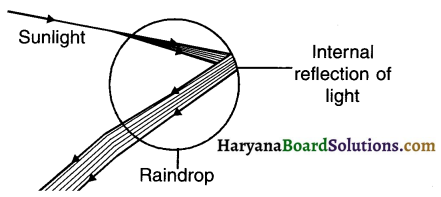
Question 30.
What is atmospheric retraction?
Answer:
Atmospheric retraction is the deviation of light or other electromagnetic waves from a straight line as it passes through the atmosphere due to the variation in air density.
Question 31.
Why is the density of earth’s atmosphere non-uniform everywhere?
Answer:
Because it consists of layers of different densities
Question 32.
Define Tyndall effect.
Answer:
The scattering of light in the nature due to small particles present in the atmosphere is called Tyndall effect.
Question 33.
Why can we see sun about two minutes before the actual sunrise?
Answer:
Because of the refraction of the light by atmosphere
Question 34.
Why does the sky appear dark to passengers flying at very high altitudes?
Answer:
Scattering of light is not possible at such heights. Hence, ………………….
Fill in the Blanks:
1. The light rays coming from the object first enter the eye through ……………
Answer:
Cornea
2. Retina is a …………. type of screen.
Answer:
Light-sensitive
3. An aperture of an eye behind the cornea at the center is known as ………………
Answer:
Pupil
![]()
4. Through the optic nerves, the electrical signals are sent to the …………..
Answer:
Brain
5. The focal length of tens changes with the change in the ……….. of an eye lens.
Answer:
Curvature
6. The ability of an eye to adjust focal length of the eye lens as per requirement is known as of ……………. an eye.
Answer:
Accommodation power
7. Least distance of distinct vision is also called ……………
Answer:
Near point of an eye
8. Myopia is also known as ……………….
Answer:
Near sightedness
9. If lens remain thin and does not become thick as per requirement, rays coming from nearby object are less refracted and are focused behind…
Answer:
The retina
10. The angle of incidence at which the angle of refraction is 900 is called …………
Answer:
Critical angle
11. Splitting of white light into seven colours is known as …………….
Answer:
Dispersion
12. In ………….. medium, violet coloured light is deviated maximum.
Answer:
Transparent
13. Recombining the seven colours of spectrum gives …………. colour.
Answer:
White
14. The deflection of light by minute particles and molecules in all the directions is known as …………….
Answer:
Scattering of light
![]()
15. If the size of scattering particle is much bigger the scattering light appears ………….. coloured.
Answer:
White
16. When Newton further tried to split the colours of the spectrum of white light by using another prism
Answer:
He could not get any more colours.
17. Any light tat gives a spectrum similar to that of sunlight is often referred as ………….
Answer:
White light
18. In total refractions and reflections take place in the water droplet for the formation of a rainbow.
Answer:
Three
19. In Tyndall effect, the light rays reach us after deflection of light in all the direction from …………….
Answer:
Colloidal particles
20. The time difference between the actual sunset and apparent sunset is about …………….
Answer:
2 minutes
True Or False
1. A muscular diaphragm behind the cornea is known as pupil. — False
2. The ciliary muscles helps in changing the thickness of the eye lens. — True
3. If eye lens do not become thin as per requirement but remain thick only, then rays coming from distant object after being refracted by lens can be focused before the retina. — True
4. In bifocal lens, the lower part of a small circular section is made up of convex lens. — True
5. Contact lens is widely used to remove the defect of eye. — True
6. Cataract causes only partial loss of vision. — False
7. Myopia can be cured with convex lens. — False
8. A water droplet can act like a small prism. — True
9. Atmospheric layer at lower altitude is colder and denser as compared to layer at higher altitude. — True
10. When the sun is below the horizon, sunhiit reaches to our eyes after being reflected in the atmosphere. — False
![]()
Match the Following
| Column I. | Column II. |
| (1) Myopia | (p) The focal length of the eye lens increases |
| (2) Hypermetropia | (q) The focal length of the eye lens decreases |
| (3) Presbyopia | (r) The power of accommodatior of the eye decreases with ageing |
Answer: 1-q, 2-p, 3-r
| Column I. | Column II. |
| (1) Twinkle of stars | (a) Tiny water droplets present (or suspended) in the atmosphere |
| (2) Blue coloured sky | (b) Band of colours |
| (3) Rainbow | (c) Scattering of light |
| (4) Spectrum | (d) Uneven atmosphere |
Answer: 1-d, 2-c, 3-a, 4-b